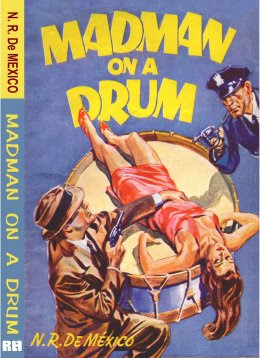In 1944, a noir suspense novel, a paperback original, was issued by a small paperback publisher out of New York. Madman on a Drum would be the first full-length book written by one N.R. De Mexico. In 1951, De Mexico wrote a book that would put his name into the Congressional Record, front and center in a debate about the negative effect of paperback literature on American culture. That book, Marijuana Girl, would become Exhibit A in Rep. Ezekiel C. Gathings’ Congressional Sub-Committee‘s mini-crusade against drug use in popular literature.
Who was this N. R. De Mexico and why should we care?
 Until recently, the true identity of this author was uncertain. In my book, Dope Menace: The Sensational World of Drug Paperbacks 1900-1975, I credit Marijuana Girl to either pulp writer Dallas McCord Reyblds or Lawrence Taylor Show, based upon the most reliable info available at the time. In an unrelated footnote, however, I mention “Bob De Mexico” in relation to another book, note the similarity to “N.R. De Mexico,” but, as I could not at that time firmly connect the two as one and the same person, I erred on the side of caution and resisted the temptation to do so.
Until recently, the true identity of this author was uncertain. In my book, Dope Menace: The Sensational World of Drug Paperbacks 1900-1975, I credit Marijuana Girl to either pulp writer Dallas McCord Reyblds or Lawrence Taylor Show, based upon the most reliable info available at the time. In an unrelated footnote, however, I mention “Bob De Mexico” in relation to another book, note the similarity to “N.R. De Mexico,” but, as I could not at that time firmly connect the two as one and the same person, I erred on the side of caution and resisted the temptation to do so.
“Bob de Mexico” had been firmly identified as Robert Bragg by sexual folklorist Gershon Legman in his introduction to Patrick J. Kearney‘s The Private Case (1981), the definitive bibliography of the British Library’s collection of erotica. In Legman’s monograph Bawdy Monologues and Rhymed Recitations (1976) Robert Bragg is noted as N.R. De Mexico.
“The most extreme statement of this kind is a recitation called variously “A Girl’s Prayer,” “The Yeomanette,” and other titles, first recorded in the scarce erotic miscellany, Cleopatra’s Scrapbook (‘Blue Grass, Kentucky’ [Wheeling, W.Va.?] 1928: copy, Kinsey Library) p. 53. This begins romantically, “Put your arms around me, darling,” and so forth, each stanza becoming more and more passionate, though never omitting the “darling” — in deference to the presumed female character of the speaker — until it ends in a blaze of castratory (vagina dentata) passion, after the orgasm: “Break it off and let it stay!” Other texts of this recitation are longer and much heightened in their eroticism, in one case by a man known to me. The pornography and “fantasy”-fiction writer, N. R. de Mexico (Robert Bragg, who is not the man just referred to, and who was born in New Jersey), was accustomed to deliver this piece at mixed parties. Although he did not change the already-supercharged text, he would attempt to heighten still further its tone of female erotic acceptance and passion by reciting, or rather crooning it, in a special dialect accent” (page 111).
The Bragg-N.R. De Mexico connection was recently cemented for all time when a fellow named Fender Tucker, one of the yeoman, blue-collar fan-bibliographers who’ve taken it upon themselves to do the messy and difficult work of investigating the world of vintage paperbacks to bring to light the stories behind these books and their authors (and without whom I would not be able to do my work in the field) ran with the question.
Fender Tucker found Robert Bragg’s son, corresponded with him, and definitively nailed Bragg as N.R. De Mexico.
Writing it up for Paperback Parade (Gryphon Books), Brooklyn-based novelist and vintage paperback dealer Gary Lovisi‘s magazine for paperback collectors, Tucker wrote:
“According to his son, Kim, ‘the pen name N.R. de Mexico means ‘N’ for nee (born), ‘R’ for Robert of Mexico. I think the Mexico was a gag because at one point he had taught himself to speak Spanish well enough for him to translate for some additional income. During the war he worked for military intelligence. In the years just after WWII he was an editor for an architectural magazine, and only began writing novels after that period'” (Paperback Parade #69, pp 95-97).
Robert Campbell Bragg (1918-1954), aka Bob De Mexico and N. R. De Mexico, holds a very special – if obscure – place in American letters. From the late 1930s through the early 1940s he wrote clandestine erotic manuscripts for a wealthy private collector in Oklahoma. A bohemian in the literary and art scene of Greenwich Village, he did so as one of Anais Nin‘s circle of friends enlisted by her to crank out erotica for this collector. Legman was the intermediary.
I’ve written about this collector and the writers who supplied him with erotic manuscripts elsewhere in a Part One and Part Two feature. I’m pleased to finally be able to report that the mystery of “Who is N.R. De Maxico” is solved, case closed.
__________
Books by Robert Campbell Bragg: Madman on a Drum (1944), a noir suspense thriller; Color TV, Now or Later?: A Comparative Survey and Analysis of the Several Color Systems and Their Impact on the Industry (1950); Marijuana Girl (1951); Strange Pursuit (1951); Designs (1951), a book about crime, gambling, prostitution; and Private Chauffeur (1952), an aviation thriller.
Images of Madman on a Drum and Private Chauffuer courtesy of Fender Tucker, who has reissued the novels of “N.R. De Mexico” through his Ramble House imprint.



